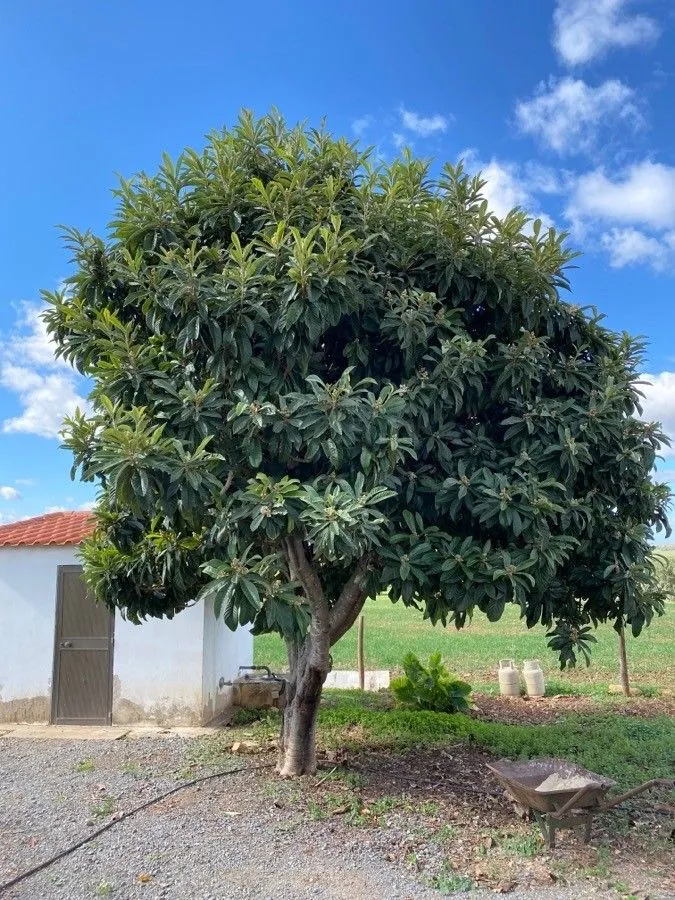
Author: (Thunb.) Lindl.
Bibliography: Trans. Linn. Soc. London 13: 102 (1821)
Year: 1821
Status: accepted
Rank: species
Genus: Eriobotrya
Vegetable: False
Observations: Unknown
The Loquat, scientifically known as Eriobotrya japonica, is a captivating fruit-bearing tree belonging to the family Rosaceae. This attractive and versatile species was first formally described in 1821 in the Transactions of the Linnean Society of London, through the combined efforts of the original identifier Thunberg and the later work of John Lindley.
The loquat tree is celebrated not only for its ornamental appeal but also for its delicious, pome fruits which have long been cherished in various cuisines around the world. Characterized by its broad, evergreen leaves, Eriobotrya japonica lends a lush, tropical aesthetic to gardens and landscapes. The tree’s glossy, dark green foliage contrasts beautifully with its clusters of fragrant white flowers that bloom during the cooler months, adding a sensory delight to any environment it inhabits.
As a member of the Rosaceae family, the loquat shares lineage with other well-known fruits such as apples, pears, and cherries, contributing to its horticultural significance. The fruit, typically ripening in the spring, is small and oval-shaped, with a thin, downy skin that ranges in color from yellow to orange. The inner flesh is succulent and can be either sweet or slightly tangy, depending on the variant and growing conditions.
Native to southeastern China, the loquat has been cultivated for thousands of years and has spread to various parts of the world, including Japan, which played a substantial role in its nomenclature. The tree’s resilience and adaptability make it a favorite among growers in temperate to subtropical climates, where it thrives and produces abundant yields.
While specific observational data for this plant remains largely undocumented in historical texts, modern horticulturists and botanists continue to explore its properties and benefits. The loquat’s unique blend of aesthetic beauty and practical fruit production ensures its continued appreciation and cultivation across diverse regions and cultures.
En: Loquat, Japanese-medlar, Bibasse, Chinese Loquat, Chinese Plum, Japanese Medlar, Japanese plum
Af: Lukwart
Sq: Loquat
Ar: بشملة يابانية
Hy: Նորաշխարհ
Az: Yapon əzgili
Eu: Japoniako mizpirondo
Be: Мушмула японская (від раслін)
Bg: Японска мушмула
Ca: Nesprer del Japó
Zh: Pi ba, 枇杷
Hr: Japanska mušmula
Cs: Mišpule
Nl: Loquat, Japanse Mispel
Eo: Lanmespilo
Fi: Japaninmispeli
Fr: Néflier du Japon, Bibassier, Bibacier, Loquat, Ériobotrya du Japon, Bibasse, Ériobotrie du Japon
Gl: Nespereira
Ka: Მუშმულა სუბტროპიკული
De: Japanische Mispel, Japanische Wollmispel, Loquat, Loquate, Mispero, Nespolo, Nispero
El: Μουσμουλιά
Ht: Lokwat
He: שסק יפני, Japanese loquat, שסק
Hu: Japánnaspolya
Id: Loquat
Ga: Locuat
It: Nespolo del Giappone, Eriobotrya japonica
Kk: Жапон мушмуласы
Rw: Umunoferiya
Ko: 비파나무
Lv: Japānas eriobotrija
Lt: Japoninė lokva
Mt: Naspli
No: Japansk mispel
Or: ଲୋକ୍ୱେଟ୍
Pa: ਲੋਕਾਟ(ਫਲ)
Fa: ازگیل ژاپنی
Pl: Nieśplik japoński
Pt: Nespereira, Ameixa, Nêspera., Ameixa-japonesa, Nêspera, Magnólio, Nespereira-do-japão, Nespereiro do Japão
Ro: Moșmon japonez
Ru: Мушмула японская обыкновенная
Sc: Nespula
Sr: Јапанска мушмула
Sd: لوڪٽ
Sk: Mišpuľa japonská
Es: Níspero, Níspero del Japón, Nispolero, Níspero., Japonska nešplja, Agrios, Nespereira, Nispero del Japón, Nispolero del Japón, Nispelero del Japón, Hispero de Japon, Lucumo
Sw: Msambia
Sv: Japansk mispel
Zh-tw: 枇杷
Ta: லக்கோட்டா
Th: โลควอท
Bo: ཞུ་མཁན།
To: Loketi
Tr: Malta eriği, Yenidunya
Uk: Локва
Ur: لوکاٹ
Vi: Nhót tây
Za: Makbizbaz
Taken Dec 5, 2017 by jose (cc-by-sa)
Taken Dec 5, 2017 by jose (cc-by-sa)
Taken Jan 1, 2010 by Marc Vercaigne (cc-by-sa)
Taken Dec 5, 2017 by jose (cc-by-sa)
Taken Dec 5, 2017 by jose (cc-by-sa)
Taken Dec 5, 2017 by jose (cc-by-sa)
Taken Dec 21, 2021 by Marzanna Bug (cc-by-sa)
Taken Nov 7, 2017 by Marcek Polling (cc-by-sa)
Taken Dec 21, 2021 by Marzanna Bug (cc-by-sa)
Taken Dec 5, 2017 by jose (cc-by-sa)
Taken Feb 16, 2019 by Pedro González (cc-by-sa)
Taken Jun 4, 2021 by Johann Pock (cc-by-sa)
Taken Jun 2, 2017 by Mario Cman (cc-by-sa)
Taken May 21, 2019 by Peñaranda Antonio Peñaranda (cc-by-sa)
Taken May 20, 2017 by Tela Botanica − Liliane ROUBAUDI (cc-by-sa)
Taken Oct 17, 2021 by Berke Çevik (cc-by-sa)
Taken Oct 28, 2021 by Benitez Mario (cc-by-sa)
Taken Feb 2, 2022 by Manuëlle (cc-by-sa)
Taken Oct 26, 2022 by Nathalie Potel (cc-by-sa)
Taken Jul 15, 2021 by Manuëlle (cc-by-sa)
Taken Oct 26, 2022 by Nathalie Potel (cc-by-sa)
Taken Nov 3, 2021 by Gianni Del Bufalo (cc-by-sa)
Taken Nov 6, 2022 by Fabrice Rubio (cc-by-sa)
Taken Jul 15, 2021 by Manuëlle (cc-by-sa)
Taken Oct 14, 2021 by Manuëlle (cc-by-sa)
Taken Dec 22, 2021 by Anthony Raoux (cc-by-sa)
Taken Nov 6, 2022 by Fabrice Rubio (cc-by-sa)
Taken Oct 14, 2021 by Manuëlle (cc-by-sa)
Taken Nov 3, 2021 by Jacques Zuber (cc-by-sa)
Taken Feb 25, 2022 by Enrico Bettineschi (cc-by-sa)
Growth habit: Tree
Family: Myrtaceae Author: (F.Muell.) K.D.Hill & L.A.S.Johnson Bibliography: Telopea 6: 402 (1995) Year: 1995 Status:…
Family: Rubiaceae Author: Pierre ex A.Froehner Bibliography: Notizbl. Bot. Gart. Berlin-Dahlem 1: 237 (1897) Year:…
Family: Sapindaceae Author: Koidz. Bibliography: J. Coll. Sci. Imp. Univ. Tokyo 32(1): 38 (1911) Year:…
Family: Asteraceae Author: A.Gray Bibliography: Pacif. Railr. Rep.: 107 (1857) Year: 1857 Status: accepted Rank:…
Family: Fabaceae Author: Medik. Bibliography: Vorles. Churpfälz. Phys.-Ökon. Ges. 2: 398 (1787) Year: 1787 Status:…
Family: Aspleniaceae Author: (Cav.) Alston Bibliography: Bull. Misc. Inform. Kew 1932: 309 (1932) Year: 1932…